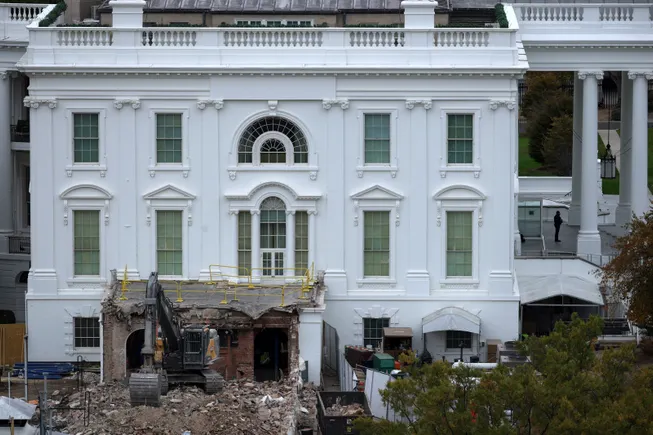The images of the East Wing demolition at the White House stood in stark contrast to the modest alterations originally floated by the White House in July.
When first announced to the public, President Donald Trump said the ballroom project “won’t interfere with the current building” and would sit “near it but not touching it.” Instead, excavators clawed through century-old walls and demolished the East Wing this month.
In its place, on what is now a sprawling site of dirt and equipment, the White House plans a 90,000-square-foot, $300 million ballroom.
Historic renovations come with surprises
Although the project shocked many who expected a smaller renovation, contractors say scope changes are far from rare on historic renovation projects.
“When you’re working on a historic restoration, it’s almost inevitable you will encounter surprises once you begin opening walls,” said Ralph Esposito, national president at Suffolk. “These structures often have undocumented changes, outdated material or hidden conditions that only reveal themselves once that work begins.”
Esposito encountered this during Suffolk’s renovation of the Waldorf Astoria in New York City. As with many historic buildings, original drawings didn’t always match reality. One beam listed as a foot wide in the plans turned out to be three feet wide, Esposito said.
In the end, the team converted the 1931 Art Deco hotel into a mix of luxurious residences and hotel rooms.
“Those discoveries can drive design modifications, sequencing adjustments or even scope changes to ensure the integrity and safety of the building are preserved,” Esposito told Construction Dive. “On historic projects, it is not uncommon for the project scope to expand once demolition begins and hidden challenges are uncovered.”
Contractors say rehab projects often need to weigh when full reconstruction makes more sense than preserving what’s there. That’s a balance that can vary widely from project to project, said Esposito.
“The intent is to, wherever possible, preserve and restore the building to its original condition and purpose,” Esposito told Construction Dive. “This is a very thoughtful and collaborative process that includes landmark and preservation consultants, ownership and construction expertise.”
East wing project shakeup
Yet, that didn’t appear to be the case at the East Wing. Its near complete razing came as a surprise from the start. Indeed, ACECO, the Silver Spring, Maryland-based contractor leading the demolition phase, reported receiving heightened criticism online. The firm has since taken its site down.
Then, last week, Trump fired all six members of the Commission of Fine Arts, a federal board that advises presidents and Congress on the aesthetics and design of major projects in Washington, according to NBC News. The CFA would typically review projects like Trump’s ballroom. The White House reportedly said it would appoint new members, according to NBC News.
Meanwhile, the price tag of the project has since jumped to $300 million, according to the Wall Street Journal. When the White House tapped Clark Construction in September to lead the overall effort, initial estimates came in at $200 million.
But the project’s profile as a historic rebuild is not unique, particularly in Washington.
For example, just a few blocks from the White House, HITT Contracting faced its own challenges on the National Geographic’s Museum of Exploration. The project consisted of interconnected buildings, some on the National Register of Historic Places, which remained occupied throughout the construction process.
That project was slow and methodical, said Joe Kmiecinski, vice president of site operations at the Falls Church, Virginia-based contractor. The team wrote more than 500 methods of procedure documents and met daily with stakeholders to plan each task.
“We just tiptoed through a lot of complicated demolition and rebuilt while it’s occupied,” Kmiecinski told Construction Dive. “Just looking at everything two and three times.”
From that perspective, the speed and scope of the East Wing demolition and envisioned ballroom space is proceeding at a more accelerated pace.
At the White House in September, Bethesda, Maryland-based Clark said it expected to finish the build before the end of Trump’s second term in 2029. That timeline raised concerns from some that the project was moving too quickly and without sufficient oversight.
“You don’t see one of those projects go that fast,” Jonathan Jarvis, former director of the National Park Service, told the New York Times. “It’ll be a rush to get it done.”
The White House did not respond to a request for comment on the project’s scope and speed.
View the original article and our Inspiration here


Leave a Reply